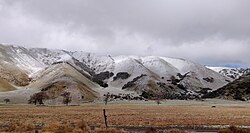Castac Valley | |
|---|---|
 Southwestern slopes of the Tehachapi Mountains in Castac Valley | |
| Coordinates: 34°50′12″N118°51′50″W / 34.83653°N 118.86399°W | |
| Location | Kern County, California |
| Range | Transverse Ranges |
| Formed by | San Andreas Fault |
| Elevation | 883 m (2,897 ft) |
Castac Valley is a valley located within the Transverse Ranges in southern Kern County, California. [1] The unincorporated community of Lebec is located within the western portion of the valley.
